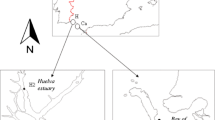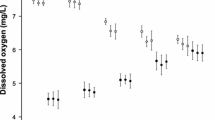Abstract
Field and laboratory studies were undertaken to determine if low pH and five metals commonly found in some ponds (Al, Cu, Fe, Pb, and Zn) might interfere with the ability of the Jefferson salamander, Ambystoma jeffersonianum, to successfully reproduce. The presence of Jefferson salamander breeding, embryonic survival, and hatching success in ten temporary ponds was correlated with levels of measured water chemistry variables (alkalinity, NO3, SO4, SiO2, DOC, PO4, Na, K, Ca, Mg, Al, Cu, Fe, Pb, Zn, pH, conductivity, TDS, temperature, and DO).
Jefferson salamander embryos (4 days post-fertilization) and 4 day post-hatch larvae were exposed to Al, Cu, Fe, Pb, and Zn at four levels and at two pHs (4.50 and 5.50) which bracketed levels commonly found in nature in temporary ponds in central Pennsylvania. Hatching success was influenced by Al and Zn. Increasing Al, Pb, and Zn concentrations had significant effects on developmental rate. Egg mass embryonic mortality was influenced by Al, Cu, and Fe. Larval mortality was significantly affected by Cu, Fe, and Zn. In conclusion, the presence of metals in temporary ponds has both positive and negative effects on reproductive success of the Jefferson salamander.
Similar content being viewed by others
References
Blem CR, Blem LB (1989) Tolerance of acidity in a Virginia population of the spotted salamander Ambystoma maculatum (Amphibia: Ambystomatidae). Brimleyana 15:37–45
—,— (1991) Cation concentration and acidity in breeding ponds of the spotted salamander, Ambystoma maculatum (Shaw) (Amphibia: Ambystomatidae), in Virginia. Brimleyana 17:67–76
Clark KL (1986) Responses of spotted salamander, Ambystoma maculatum, populations in central Ontario to habitat acidity. Can Field-Naturalist 100(4):463–469
Clark KL, Hall RJ (1985) Effects of elevated hydrogen ion and aluminum concentration on the survival of amphibian embryos and larvae. Can J Sci 42:116–123
Clark KL, LaZerte BD (1985) A laboratory study of the effects of aluminum and pH on amphibian eggs and tadpoles. Can J Fish Aqua Sci 42:1544–1551
—, — (1987) Interspecific variation in hydrogen ion and aluminum toxicity in Bufo americanus and Ambystoma maculatum. Can J Fish Aqua Sci 44:1622–1628
Dale JM, Freedman B, and Kerekes J (1985) Experimental studies of the effects of acidity and associated water chemistry on amphibians. Proc N S Inst Sci 35:35–54
Dunson WA, Connell J (1982) Specific inhibition of hatching in amphibian embryos by low pH. J Herpetol 3:314–316
Dunson WA, Wyman RL, Corbett ES (1992) A symposium on amphibian declines and habitat acidification. J Herpetol 26(4):349–352
Freda J (1986) The influence of acidic pond water on amphibians: A review. Water, Air, Soil Pollut 30:439–450
— (1991) The effects of aluminum and other metals on amphibians. Environ Pollut 71:305–328
Freda J, Dunson WA (1985a) The influence of external cation concentration on the hatching of amphibian embryos in water of low pH. Can J Zool 63:2649–2656
—, — (1985b) The effect of acidic precipitation on amphibian breeding in temporary ponds in Pennsylvania. US Fish and Wildlife Service, Eastern Energy and Land Use Team. Biol Rep 80(40.22), 85 pp
—, — (1986) Effects of low pH and other chemical variables on the local distribution of amphibians. Copeia 1986(2):454–466
Freda J, McDonald DG (1989) Effects of Al on the leopard frog Rana pipiens: Lifestage comparisons and aluminum uptake. Can J Fish Aqua Sci 47:210–216
Freda J, Cavdek V, and McDonald DG (1990) Role of organic complexation in the toxicity of aluminum to Rana pipiens embryos and Bufo americanus tadpoles. Can J Fish Aqua Sci 47:217–224
Freda J, Sadinski WJ, Dunson WA (1991) Long term monitoring of amphibian populations with respect to the effects of acidic deposition. Water, Air, Soil Pollut 55:445–462
Harfenist A, Power T, Clark KL, Peakall DB (1989) A review and evaluation of the amphibian toxicological literature. Technical Report #61, Canadian Wildlife Service, Headquarters
Pierce BA (1993) The effects of acid precipitation on amphibians. Ecotoxicol 2:65–77
Rowe CL, Sadinski WJ, Dunson WA (1992) Effects of acute and chronic acidification on three larval amphibians that breed in temporary ponds. Arch Environ Contam Toxicol 23:339–350
Rowe CL, Dunson WA (1993) Relationships among abiotic parameters and breeding effort by three amphibians in temporary wetlands of central Pennsylvania. Wetlands 13(4):237–246
Rugh R (1962) Experimental Embryology. Burgess Publishing Co. Minneapolis, 501 pp
Sadinski WJ (1991) Direct and indirect effects of low pH on the communities of temporary ponds. The Pennsylvania State University. PhD thesis in Ecology. University Park, PA, 253 pp
Sadinski WJ, Dunson WA (1992) A multilevel study of the effects of low pH on amphibians of temporary ponds. J Herpetol 26:413–422
Tyler-Jones R, Beattie RC, Aston RJ (1989) The effects of acid water and aluminum on the embryonic development of the common frog, Rana temporaria. J Zool London 219:355–372
Author information
Authors and Affiliations
Rights and permissions
About this article
Cite this article
Horne, M.T., Dunson, W.A. Toxicity of metals and low pH to embryos and larvae of the Jefferson salamander, Ambystoma jeffersoniannum . Arch. Environ. Contam. Toxicol. 29, 110–114 (1995). https://doi.org/10.1007/BF00213095
Received:
Revised:
Issue Date:
DOI: https://doi.org/10.1007/BF00213095




